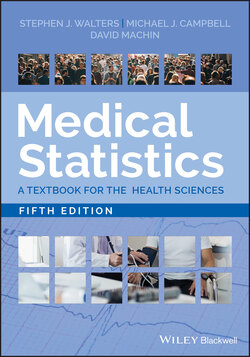Читать книгу Medical Statistics - David Machin - Страница 77
Illustrative Example – RCT of Salicylic Acid Plasters for Treatment of Foot Corns
ОглавлениеFarndon et al. (2013) reports a randomised controlled trial which investigated the effectiveness of salicylic acid plasters compared with usual scalpel debridement for treatment of foot corns. One categorical variable recorded was the location or anatomical site of the corn on the foot in six categories as displayed in Table 3.1. The first column shows category names, whilst the second shows the number of individuals in each category together with its percentage contribution to the total. We can see that corns are most likely on the metatarsal head.
Table 3.1 Anatomical site of foot corn of 201 patients with corns
(Source: data from Farndon et al. 2013).
| Anatomical site of index corn on foot | Frequency | (%) |
|---|---|---|
| Apex (end of toe) | 13 | 7 |
| Proximal interphalangeal joint (middle part of toe – on the top) | 27 | 13 |
| Interdigital (between the toes) | 16 | 8 |
| Metatarsal head (ball of the foot – on the bottom) | 119 | 59 |
| Plantar calcaneus (heel) | 6 | 35 |
| Other part of foot | 20 | 10 |
| Total | 201 | 100 |
We might be interested in whether the corn site is related to the gender of the patient. Table 3.2 shows the distribution of corn site by gender; in this case it can be said that corn site type has been cross‐tabulated with gender. We can see that the distribution of sites for corns is similar for males and females. Table 3.2 is an example of a contingency table with six rows (representing corn site) and two columns (gender). Note that we are interested in the distribution of the site where the corn is located on the foot within gender, and so the percentages add up to 100 down each column, rather than across the rows.
Table 3.2 Cross‐tabulation of anatomical site of corn by gender for 201 patients with corns on feet
(Source: data from Farndon et al. 2013).
| Gender | ||||
|---|---|---|---|---|
| Anatomical site of index corn on foot | Male | Female | ||
| n | (%) | n | (%) | |
| Apex (end of toe) | 4 | (5) | 9 | (8) |
| Proximal interphalangeal joint (middle part of toe – on the top) | 8 | (10) | 19 | (16) |
| Interdigital (between the toes) | 5 | (6) | 11 | (9) |
| Metatarsal head (ball of the foot – on the bottom) | 54 | (64) | 65 | (56) |
| Plantar calcaneus (heel) | 3 | (4) | 3 | (3) |
| Other part of foot | 10 | (12) | 10 | (9) |
| Total | 84 | (100) | 117 | (100) |
As an example of the importance of considering relative proportions Furness et al. (2003) reported in Auckland, New Zealand over a one‐year period that 25.6% of road accidents were to white cars. As a consequence, a New Zealander may think twice about buying a white car! White cars were the most prevalent colour on the roads with a proportion of 25.9%. So about a quarter of cars on the road are white and this is the same as the proportion of road accidents that were in white cars; thus white cars are not more dangerous than other colours.
